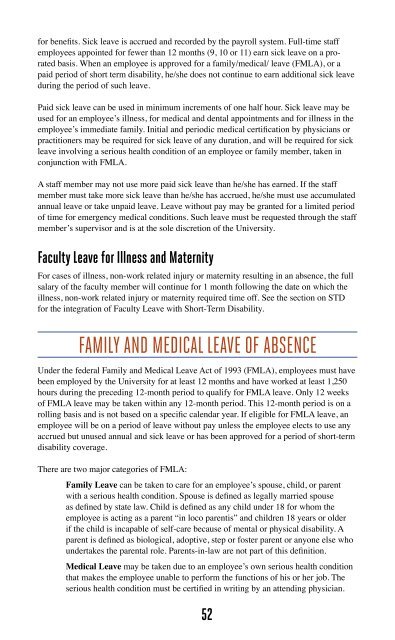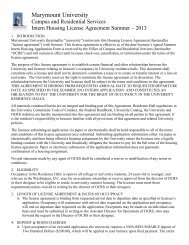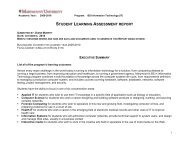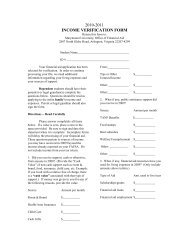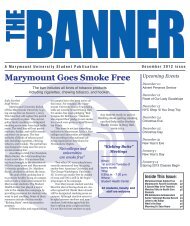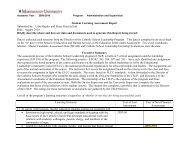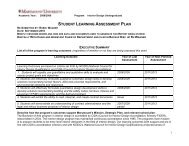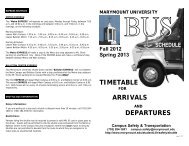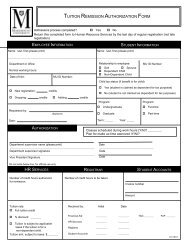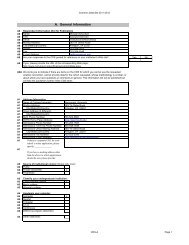EmployEE Handbook - Marymount University
EmployEE Handbook - Marymount University
EmployEE Handbook - Marymount University
You also want an ePaper? Increase the reach of your titles
YUMPU automatically turns print PDFs into web optimized ePapers that Google loves.
for benefits. Sick leave is accrued and recorded by the payroll system. Full-time staff<br />
employees appointed for fewer than 12 months (9, 10 or 11) earn sick leave on a prorated<br />
basis. When an employee is approved for a family/medical/ leave (FMLA), or a<br />
paid period of short term disability, he/she does not continue to earn additional sick leave<br />
during the period of such leave.<br />
Paid sick leave can be used in minimum increments of one half hour. Sick leave may be<br />
used for an employee’s illness, for medical and dental appointments and for illness in the<br />
employee’s immediate family. Initial and periodic medical certification by physicians or<br />
practitioners may be required for sick leave of any duration, and will be required for sick<br />
leave involving a serious health condition of an employee or family member, taken in<br />
conjunction with FMLA.<br />
A staff member may not use more paid sick leave than he/she has earned. If the staff<br />
member must take more sick leave than he/she has accrued, he/she must use accumulated<br />
annual leave or take unpaid leave. Leave without pay may be granted for a limited period<br />
of time for emergency medical conditions. Such leave must be requested through the staff<br />
member’s supervisor and is at the sole discretion of the <strong>University</strong>.<br />
Faculty Leave for Illness and Maternity<br />
For cases of illness, non-work related injury or maternity resulting in an absence, the full<br />
salary of the faculty member will continue for 1 month following the date on which the<br />
illness, non-work related injury or maternity required time off. See the section on STD<br />
for the integration of Faculty Leave with Short-Term Disability.<br />
Family and Medical Leave of Absence<br />
Under the federal Family and Medical Leave Act of 1993 (FMLA), employees must have<br />
been employed by the <strong>University</strong> for at least 12 months and have worked at least 1,250<br />
hours during the preceding 12-month period to qualify for FMLA leave. Only 12 weeks<br />
of FMLA leave may be taken within any 12-month period. This 12-month period is on a<br />
rolling basis and is not based on a specific calendar year. If eligible for FMLA leave, an<br />
employee will be on a period of leave without pay unless the employee elects to use any<br />
accrued but unused annual and sick leave or has been approved for a period of short-term<br />
disability coverage.<br />
There are two major categories of FMLA:<br />
Family Leave can be taken to care for an employee’s spouse, child, or parent<br />
with a serious health condition. Spouse is defined as legally married spouse<br />
as defined by state law. Child is defined as any child under 18 for whom the<br />
employee is acting as a parent “in loco parentis” and children 18 years or older<br />
if the child is incapable of self-care because of mental or physical disability. A<br />
parent is defined as biological, adoptive, step or foster parent or anyone else who<br />
undertakes the parental role. Parents-in-law are not part of this definition.<br />
Medical Leave may be taken due to an employee’s own serious health condition<br />
that makes the employee unable to perform the functions of his or her job. The<br />
serious health condition must be certified in writing by an attending physician.<br />
52


